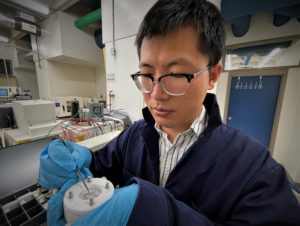
One of the key components to making renewable energies like solar and wind more widely deployed is the ability to store the energy they produce in batteries for later use. After all, we can’t generate solar energy at night or electricity from wind farms when there’s no wind.
To make renewables even more efficient and cost effective, University of Utah chemical engineering assistant professor Tao Gao has discovered that using a low-cost electrolyte made of iron ion and magnesium or calcium ions can make much cheaper and more rechargeable iron metal batteries.
Gao’s work was published last month in the latest issue of ACS Central Science. University of Utah graduate student Jing Liu was the first author, and materials science and engineering associate professor Dimitry Bedrov was a co-author of the paper, which can be read here.
Iron metal batteries are promising due to their low cost since iron is the second most abundant metal in the earth’s crust. Consequently, iron metal rechargeable batteries are cheaper than any other kind, including zinc- and lithium-based batteries, according to the paper.

But a downside to iron metal batteries is they currently do not last long because of the limited number of times they can be recharged. Iron is the negative electrode material in the battery, and it operates by iron deposition while it is charging and iron dissolution during discharging. The ability to reverse that reaction determines how many times you can recharge the battery before it dies.
There are two side reactions that occur during that process that prevents the iron negative electrode from reaching full reversibility: the decomposition of water, which generates hydrogen gas, and iron particles in the negative electrode that become inactive. “Adding magnesium or calcium ions can suppress both side reactions by changing the structure of water and the shape of the iron particle,” Gao said.
Other researchers in this area have gotten iron metal batteries to last only 10 to 20 cycles before they die, but Gao and his team say the addition of magnesium and calcium can make them go through more than 100 cycles. That’s not enough to make this idea commercially viable yet — they should reach more than 1,000 cycles — but it’s a huge step forward.
“This work presents a major breakthrough in the field of iron batteries,” Gao said. “We are currently optimizing the electrolyte to bring the cycle life from hundreds to thousands.”
If and when these batteries become commercially available, Gao believes they could be as much as 100 times cheaper than the lithium-ion batteries that solar and wind farms use today.